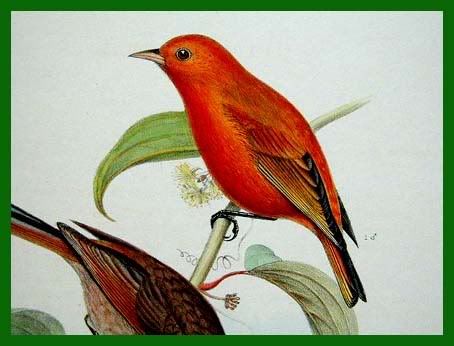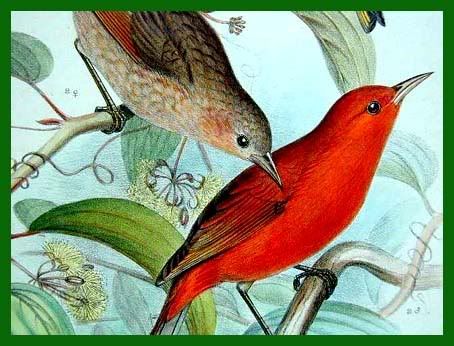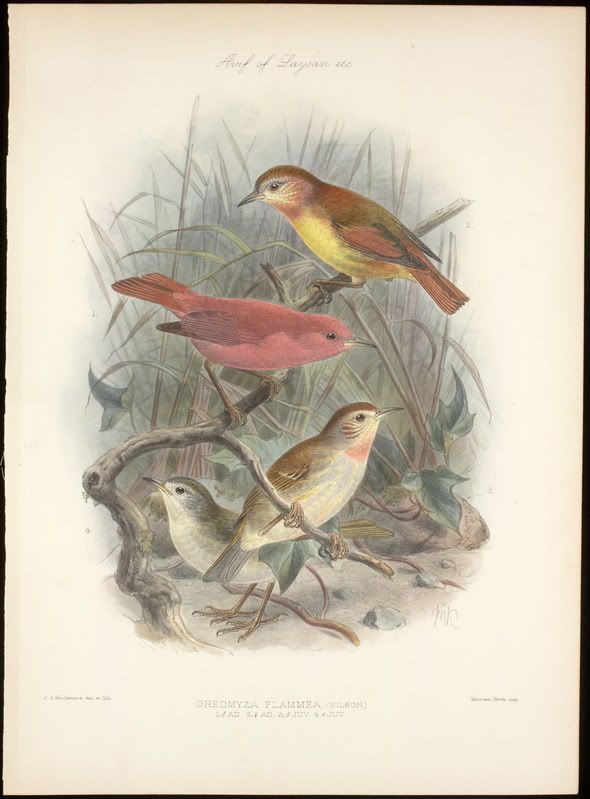Post by another specialist on Jun 17, 2005 8:15:24 GMT
DESCRIPTION AND TAXONOMY
The kâkâwahie, or Moloka`i creeper, was known only from Moloka`i, but
now is assumed to be extinct. The last sighting of this sexually dimorphic
honeycreeper occurred in April 1963 (Pekelo 1963). A detailed description of the
species was made only by the early specimen collectors and observers; Munro
(1944) described the adult males as mostly scarlet in various shades, adult
females as brown with scarlet washes and markings, and juvenile males ranging
from female-like brown to the adult males' scarlet with many gradations. The bill
was short and straight. Its calls were chip or chirping notes similar to other
creeper calls (Munro 1944, Pekelo 1963). Its closest relatives are the Maui
creeper (P. montana) and the O`ahu creeper (P. maculata).
LIFE HISTORY
Only fragmentary information is available about the life history of the
kâkâwahie from the writings of early naturalists and the few notes reported in the
1960’s (Perkins 1903, Munro 1944, Pekelo 1963). This species was an
insectivore that gleaned vegetation and bark of the wet `ôhi`a (Metrosideros
polymorpha) forests. Only minimal information exists about nests and young
Munro (1944).
HABITAT DESCRIPTION
No detailed habitat description for the species is available. The boggy
forested upper areas of Moloka`i have been reported by Munro (1944) and Pekelo
(1963) as the species’ habitat. The last detections of 1960's were on the west rim
of Pelekunu Valley on the `Ôhi`alele Plateau in moss-shrouded `ôhi`a and `ôlapa
(Cheirodendron trigynum).
HISTORICAL AND CURRENT RANGE AND STATUS
Historically, the species was recorded only from Moloka`i (Figure 15).
There have been no sightings since 1963. The 1980 Hawaiian Forest Bird Survey
failed to detect the species on Moloka`i, and reported similar failures of still
earlier searches (Scott et al. 1986). All surveys and special searches since 1988
97
have failed to detect this species (Hawai`i Department of Land and Natural
Resources 1988, U.S. Geological Survey 1995, Hawai`i Department of Land and
Natural Resources 1995, U.S. Geological Survey 1996, Reynolds and Snetsinger
2001). This species is likely extinct.
REASONS FOR DECLINE AND CURRENT THREATS
Reasons for the early decline and loss of the species are unknown, but
presumably are the same as for other endangered forest birds on Moloka`i and
Maui.
CONSERVATION EFFORTS
The Moloka`i creeper was federally listed as an endangered species on
October 13, 1970 (U.S. Fish and Wildlife Service 1970), it became protected
under the State of Hawai`i endangered species law on March 22, 1982, and was
included in the Maui-Moloka`i Forest Birds Recovery Plan (U.S. Fish and
Wildlife Service 1984a). No other specific conservation efforts for this species
have been initiated.
RECOVERY STRATEGY
See the Rare Bird Discovery Protocol in Section III. D.
ecos.fws.gov/docs/recovery_plans/2003/031016.pdf
The kâkâwahie, or Moloka`i creeper, was known only from Moloka`i, but
now is assumed to be extinct. The last sighting of this sexually dimorphic
honeycreeper occurred in April 1963 (Pekelo 1963). A detailed description of the
species was made only by the early specimen collectors and observers; Munro
(1944) described the adult males as mostly scarlet in various shades, adult
females as brown with scarlet washes and markings, and juvenile males ranging
from female-like brown to the adult males' scarlet with many gradations. The bill
was short and straight. Its calls were chip or chirping notes similar to other
creeper calls (Munro 1944, Pekelo 1963). Its closest relatives are the Maui
creeper (P. montana) and the O`ahu creeper (P. maculata).
LIFE HISTORY
Only fragmentary information is available about the life history of the
kâkâwahie from the writings of early naturalists and the few notes reported in the
1960’s (Perkins 1903, Munro 1944, Pekelo 1963). This species was an
insectivore that gleaned vegetation and bark of the wet `ôhi`a (Metrosideros
polymorpha) forests. Only minimal information exists about nests and young
Munro (1944).
HABITAT DESCRIPTION
No detailed habitat description for the species is available. The boggy
forested upper areas of Moloka`i have been reported by Munro (1944) and Pekelo
(1963) as the species’ habitat. The last detections of 1960's were on the west rim
of Pelekunu Valley on the `Ôhi`alele Plateau in moss-shrouded `ôhi`a and `ôlapa
(Cheirodendron trigynum).
HISTORICAL AND CURRENT RANGE AND STATUS
Historically, the species was recorded only from Moloka`i (Figure 15).
There have been no sightings since 1963. The 1980 Hawaiian Forest Bird Survey
failed to detect the species on Moloka`i, and reported similar failures of still
earlier searches (Scott et al. 1986). All surveys and special searches since 1988
97
have failed to detect this species (Hawai`i Department of Land and Natural
Resources 1988, U.S. Geological Survey 1995, Hawai`i Department of Land and
Natural Resources 1995, U.S. Geological Survey 1996, Reynolds and Snetsinger
2001). This species is likely extinct.
REASONS FOR DECLINE AND CURRENT THREATS
Reasons for the early decline and loss of the species are unknown, but
presumably are the same as for other endangered forest birds on Moloka`i and
Maui.
CONSERVATION EFFORTS
The Moloka`i creeper was federally listed as an endangered species on
October 13, 1970 (U.S. Fish and Wildlife Service 1970), it became protected
under the State of Hawai`i endangered species law on March 22, 1982, and was
included in the Maui-Moloka`i Forest Birds Recovery Plan (U.S. Fish and
Wildlife Service 1984a). No other specific conservation efforts for this species
have been initiated.
RECOVERY STRATEGY
See the Rare Bird Discovery Protocol in Section III. D.
ecos.fws.gov/docs/recovery_plans/2003/031016.pdf













